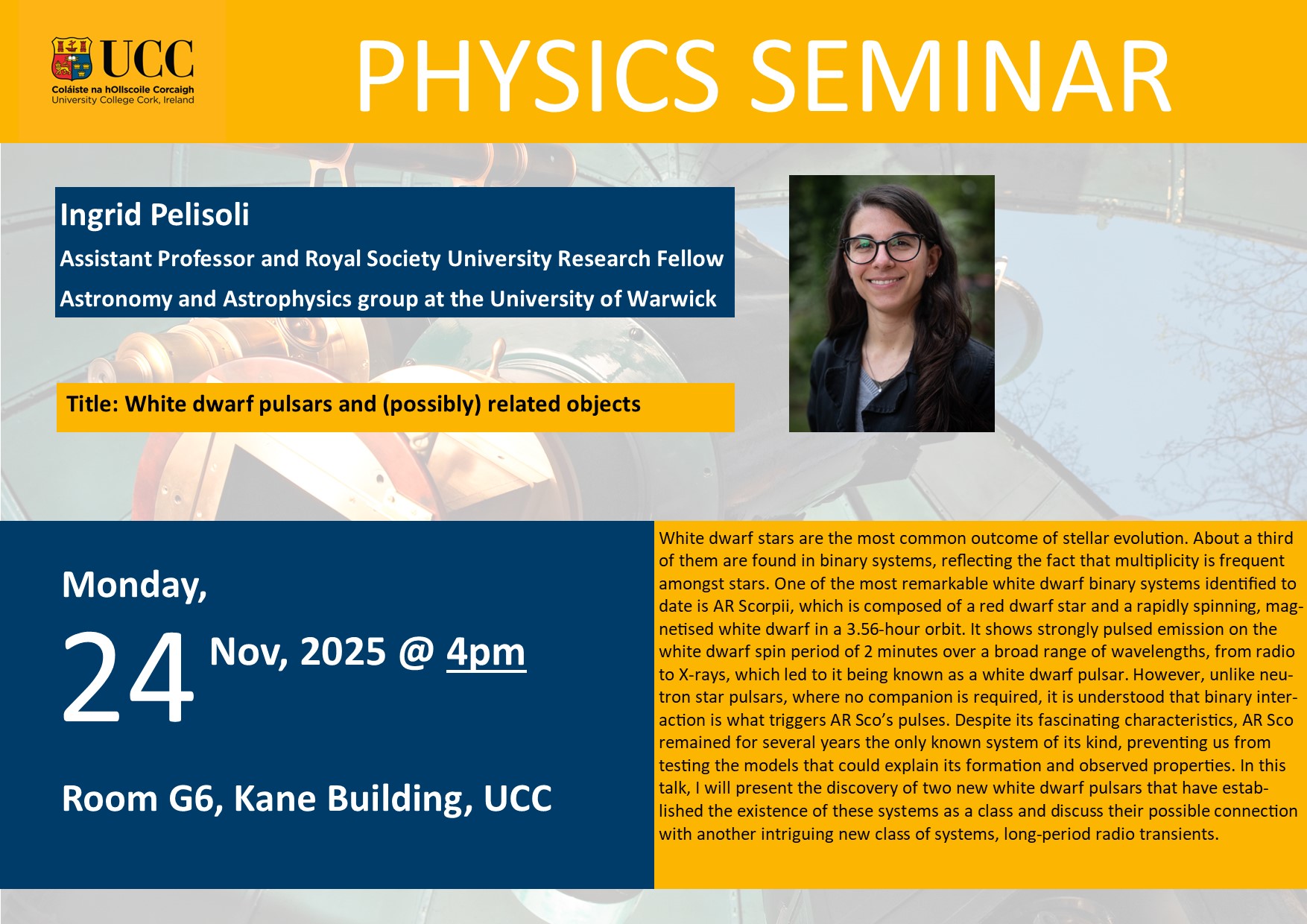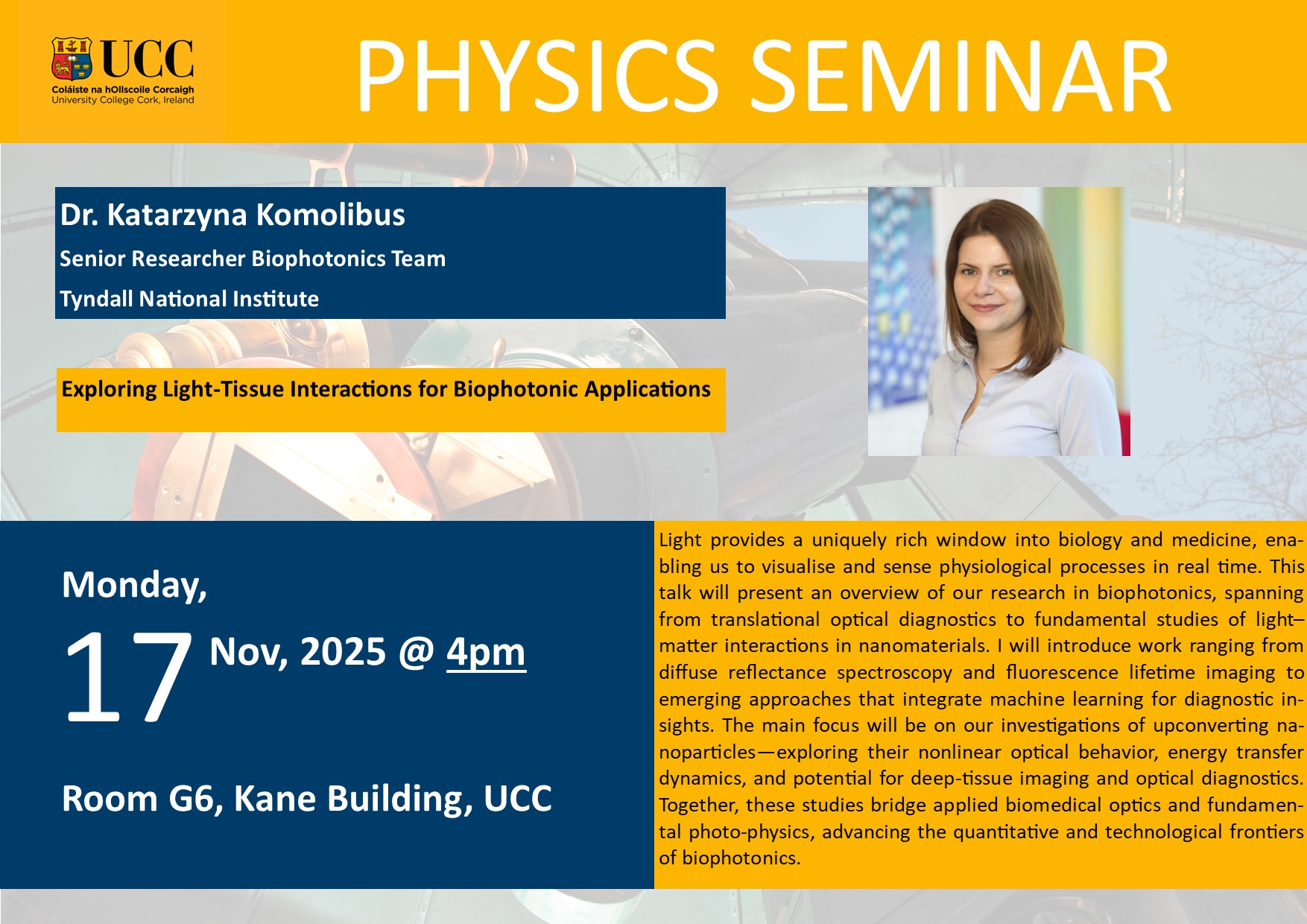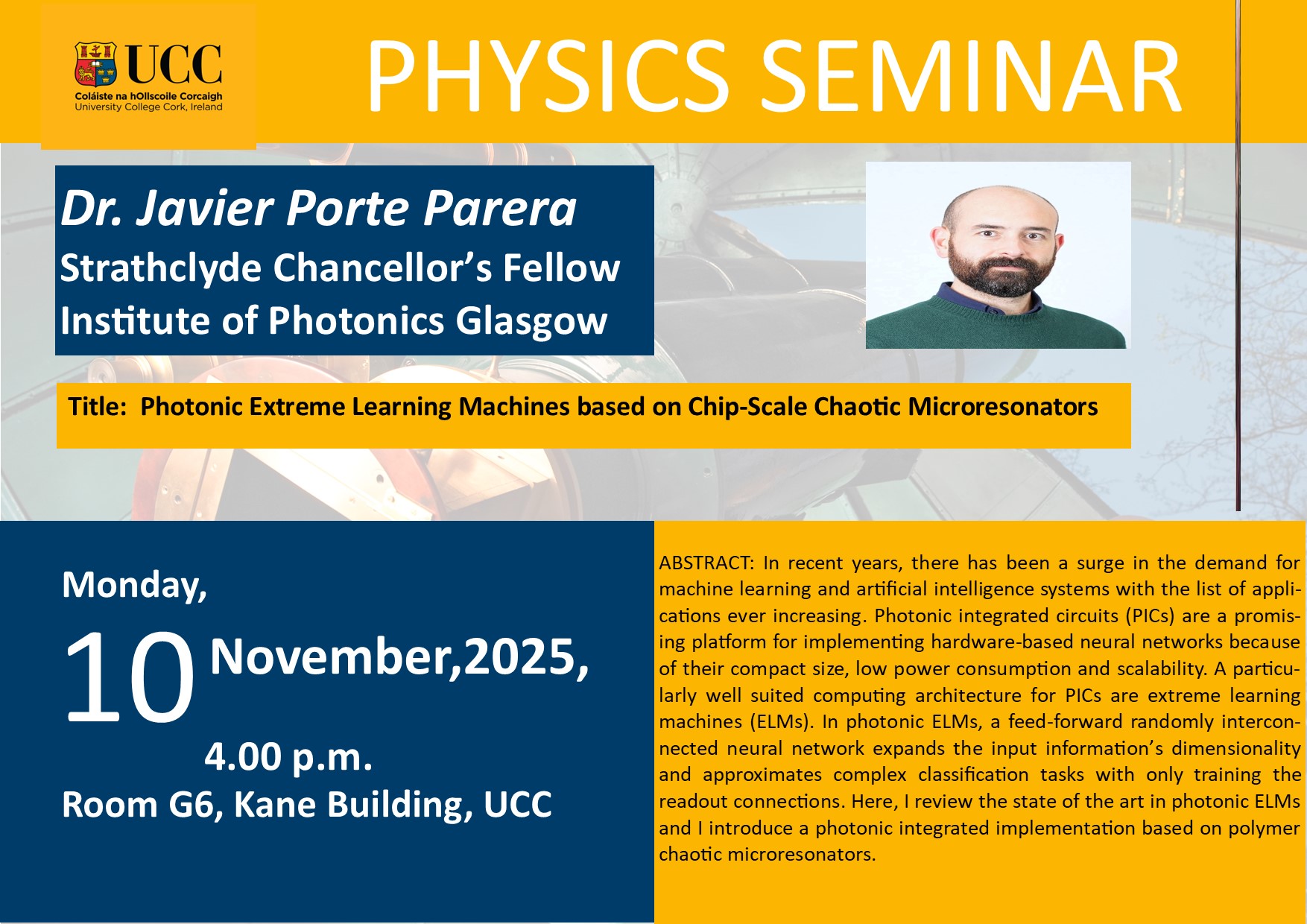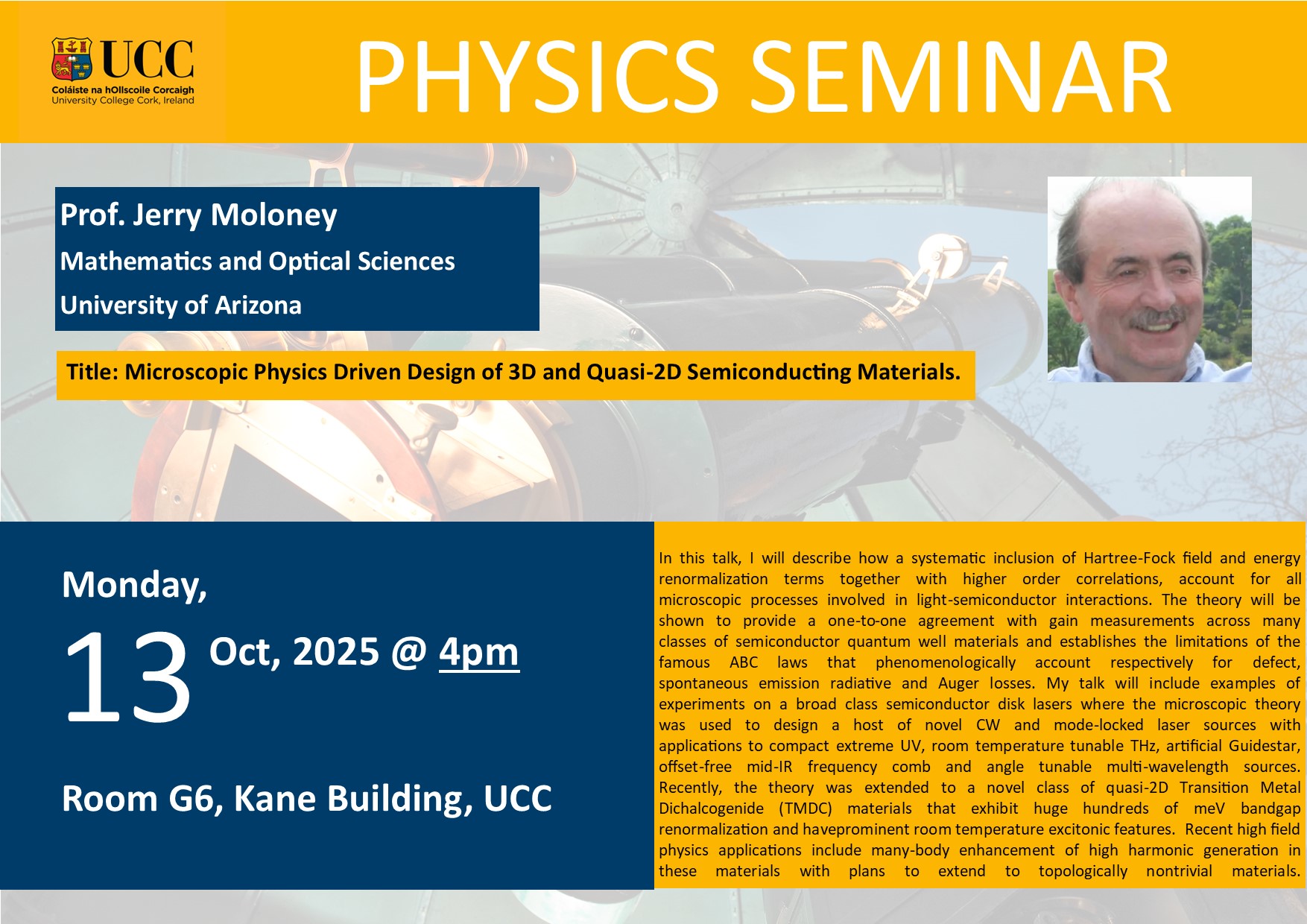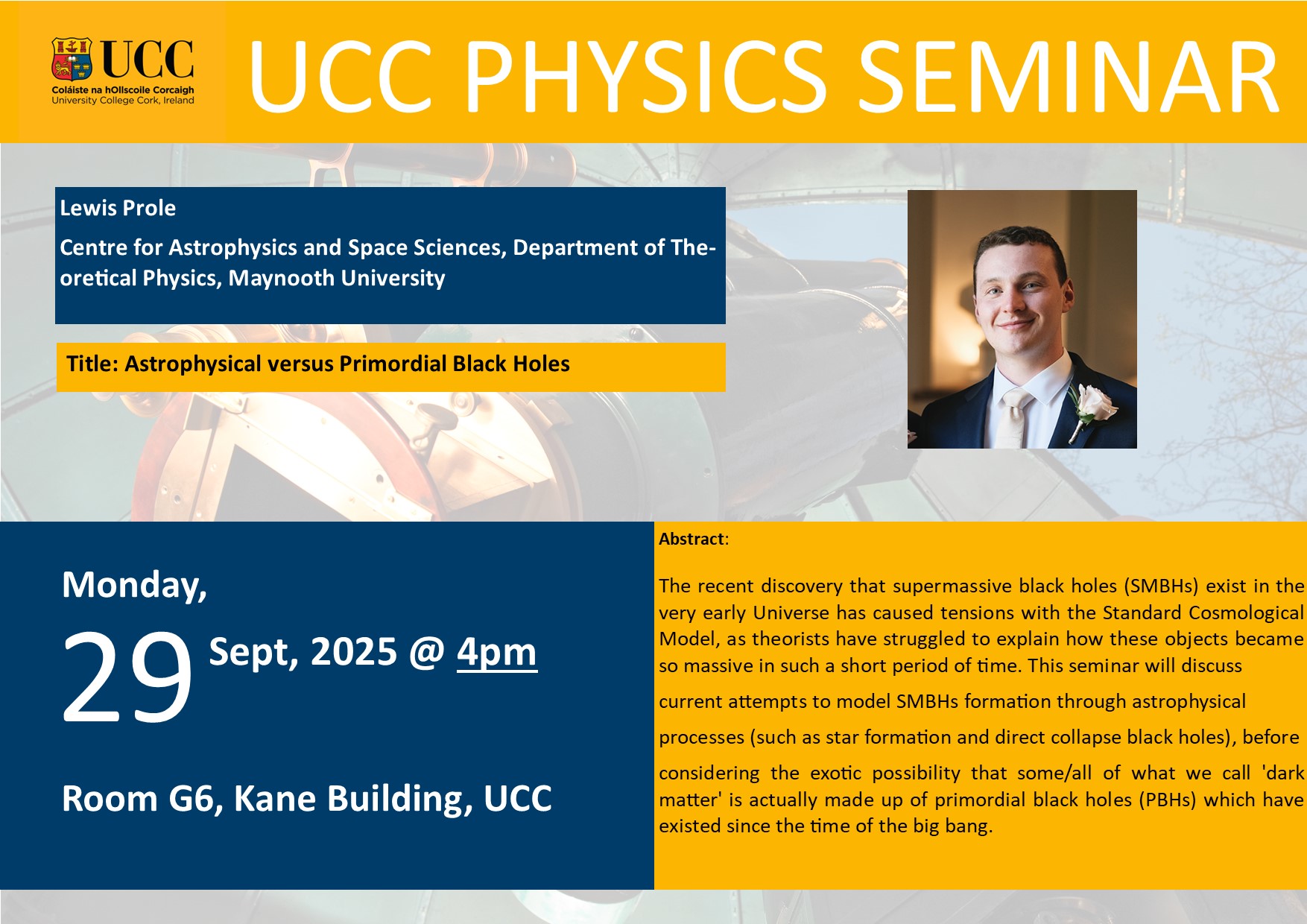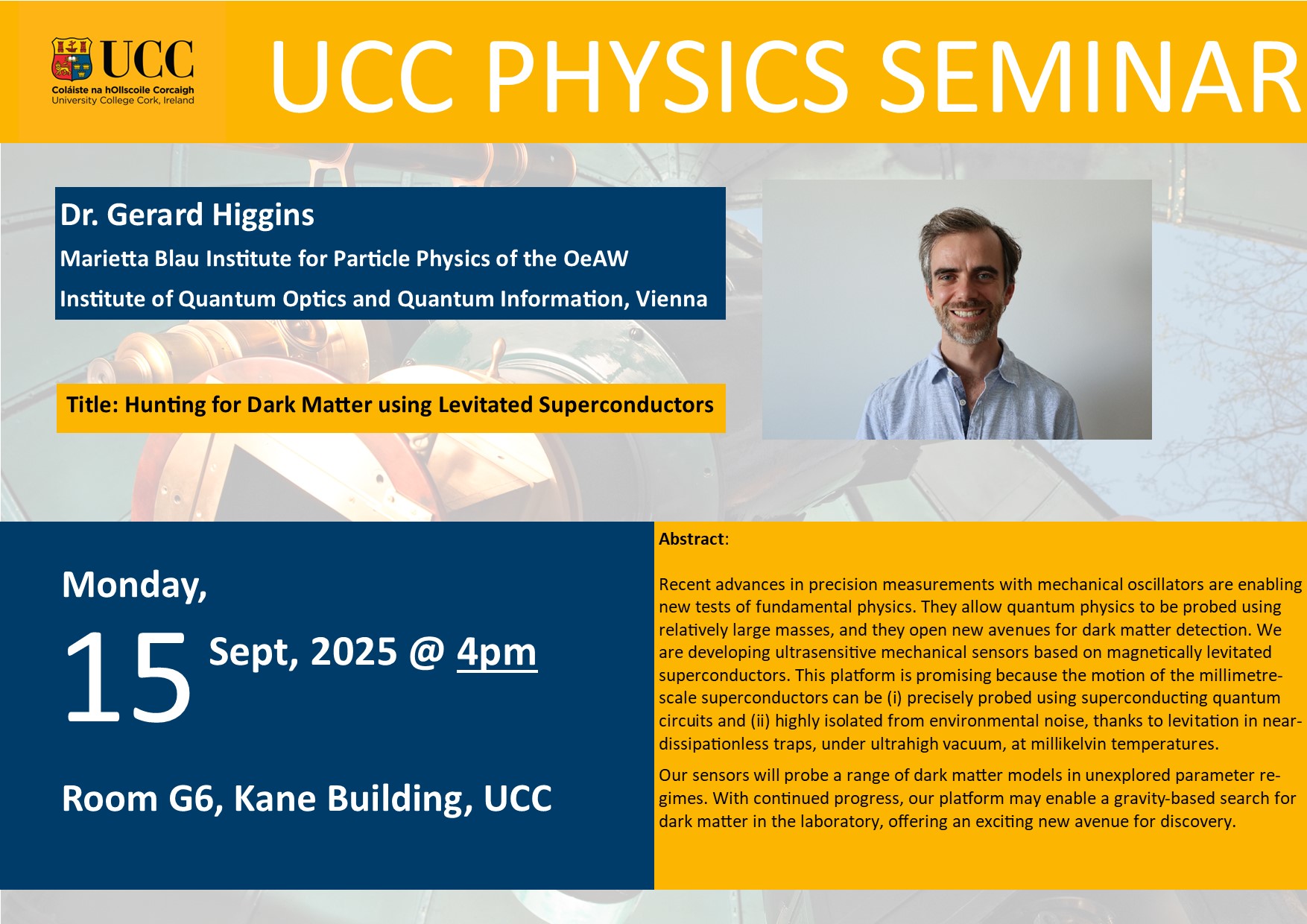- Home
- Semester and Timetable Information
- Study Physics
- Our Research
- Our People
- Careers and Alumni
- Seminars, News and Events
- Outreach and School Resources
- About the School
- What is Physics
- The Crawford Observatory
- Frequently Asked Questions
- UCC Futures Quantum & Photonics
- Supports/EDI
Seminars 2025/2026
Ingrid Pelisoli 24 Nov 2025
| Seminar Speaker |
Ingrid Pelisoli |
| Venue |
Room G06, Kane Science Building, UCC |
| Time/Date |
4pm / Monday, 24 Nov, 2025 |
| Title |
White dwarf pulsars and (possibly) related objects |
| Abstract |
White dwarf stars are the most common outcome of stellar evolution. About a third of them are found in binary systems, reflecting the fact that multiplicity is frequent amongst stars. One of the most remarkable white dwarf binary systems identified to date is AR Scorpii, which is composed of a red dwarf star and a rapidly spinning, magnetised white dwarf in a 3.56-hour orbit. It shows strongly pulsed emission on the white dwarf spin period of 2 minutes over a broad range of wavelengths, from radio to X-rays, which led to it being known as a white dwarf pulsar. However, unlike neutron star pulsars, where no companion is required, it is understood that binary interaction is what triggers AR Sco’s pulses. Despite its fascinating characteristics, AR Sco remained for several years the only known system of its kind, preventing us from testing the models that could explain its formation and observed properties. In this talk, I will present the discovery of two new white dwarf pulsars that have established the existence of these systems as a class and discuss their possible connection with another intriguing new class of systems, long-period radio transients. |
Dr. Katarzyna Komolibus 17 Nov 2025
| Seminar Speaker |
Dr. Katarzyna KomolibusDr. Katarzyna Komolibus is a senior researcher in the Biophotonics team at Tyndall National Institute. She received her MSc in Electronics and Telecommunications from Wroclaw University of Technology (2011) and her PhD in Applied Physics and Instrumentation from Cork Institute of Technology (2016). After joining Prof. Stefan Andersson-Engels’ Biophotonics@Tyndall group in 2017, she worked on optics-based surgical guidance and tissue imaging using upconverting nanoparticles. Between 2021 and 2023, she was a senior R&D biophotonics engineer at Rockley Photonics, developing silicon-photonics-based wearable sensors for health care monitoring. She now leads a sub-team at Tyndall advancing multimodal spectroscopy for diagnostic and surgical guidance applications in collaboration with clinicians and industry. |
| Venue |
Room G06, Kane Science Building, UCC |
| Time/Date |
4pm / Monday, 17 Nov, 2025 |
| Title |
Light Matters: Exploring Light-Tissue Interactions for Biophotonic Applications |
| Abstract |
Light provides a uniquely rich window into biology and medicine, enabling us to visualise and sense physiological processes in real time. This talk will present an overview of our research in biophotonics, spanning from translational optical diagnostics to fundamental studies of light–matter interactions in nanomaterials. I will introduce work ranging from diffuse reflectance spectroscopy and fluorescence lifetime imaging to emerging approaches that integrate machine learning for diagnostic insights. The main focus will be on our investigations of upconverting nanoparticles—exploring their nonlinear optical behavior, energy transfer dynamics, and potential for deep-tissue imaging and optical diagnostics. Together, these studies bridge applied biomedical optics and fundamental photo-physics, advancing the quantitative and technological frontiers of biophotonics. |
Javier Porte Parera Nov 10 2025
| Seminar Speaker |
Dr Javier Porte Parera |
| Venue |
Room G06, Kane Science Building, UCC |
| Time/Date |
4pm / Monday, 10 Nov, 2025 |
| Title |
Photonic Extreme Learning Machines based on Chip-Scale Chaotic Microresonators. |
| Abstract |
In recent years, there has been a surge in the demand for machine learning and artificial intelligence systems with the list of applications ever increasing. Photonic integrated circuits (PICs) are a promising platform for implementing hardware-based neural networks because of their compact size, low power consumption and scalability. A particularly well suited computing architecture for PICs are extreme learning machines (ELMs). In photonic ELMs, a feed-forward randomly interconnected neural network expands the input information’s dimensionality and approximates complex classification tasks with only training the readout connections. Here, I review the state of the art in photonic ELMs and I introduce a photonic integrated implementation based on polymer chaotic microresonators. |
Prof. Jerry Moloney 13 Oct 2025
| Seminar Speaker |
Prof. Jerry Moloney |
| Venue |
Room G06, Kane Science Building, UCC |
| Time/Date |
4pm / Monday, 13 Oct, 2025 |
| Title |
Microscopic Physics Driven Design of 3D and Quasi-2D Semiconducting Materials. |
| Abstract |
In this talk, I will describe how a systematic inclusion of Hartree-Fock field and energy |
Dr Lewis Prole 29 Sept 2025
| Seminar Speaker |
Dr Lewis Prole |
| Venue |
Room G06, Kane Science Building, UCC |
| Time/Date |
4pm / Monday, 29 Sept, 2025 |
| Title |
Astrophysical versus Primordial Black Holes |
| Abstract |
The recent discovery that supermassive black holes (SMBHs) exist in the very early Universe has caused tensions with the Standard Cosmological Model, as theorists have struggled to explain how these objects became so massive in such a short period of time. This seminar will discuss current attempts to model SMBHs formation through astrophysical processes (such as star formation and direct collapse black holes), before considering the exotic possibility that some/all of what we call 'dark matter' is actually made up of primordial black holes (PBHs) which have existed since the time of the big bang. |
Gerard Higgins 15 Sept 2025
| Seminar Speaker |
Gerard Higgins |
| Venue |
Room G06, Kane Science Building, UCC |
| Time/Date |
4pm / Monday, 15 Sept, 2025 |
| Title |
Hunting for Dark Matter using Levitated Superconductors |
| Abstract |
Recent advances in precision measurements with mechanical oscillators are enabling new tests of fundamental physics. They allow quantum physics to be probed using relatively large masses, and they open new avenues for dark matter detection. We are developing ultrasensitive mechanical sensors based on magnetically levitated superconductors. This platform is promising because the motion of the millimetre-scale superconductors can be (i) precisely probed using superconducting quantum circuits and (ii) highly isolated from environmental noise, thanks to levitation in near-dissipationless traps, under ultrahigh vacuum, at millikelvin temperatures. Our sensors will probe a range of dark matter models in unexplored parameter regimes. With continued progress, our platform may enable a gravity-based search for dark matter in the laboratory, offering an exciting new avenue for discovery. |
Matthew Hopkins 8 Sept 2025
| Seminar Speaker |
Matthew Hopkins |
| Venue |
Room G06, Kane Science Building, UCC |
| Time/Date |
4pm / Monday, 8 Sept, 2025 |
| Title |
The Galactic Interstellar Object Population |
| Abstract |
Sourced from distant planetary systems and forming a huge Galaxy-spanning population, the properties of interstellar objects (ISOs) depend on processes across a range of astrophysical scales. This population plays an active role in Galactic life, potentially seeding planet formation in protoplanetary disks and causing fast radio bursts in collisions with neutron stars. With the imminent Vera C. Rubin Observatory’s Legacy Survey of Space and Time (LSST) set to increase our sample of known ISOs by an order of magnitude, I will present a predicted chemodynamical model of the ISO population derived using the Gaia stellar survey and models of protoplanetary disk chemistry, along with a simulation of ISO discoveries in the LSST. I predict that the Galactic ISO population has a complex velocity distribution which is correlated with both chemical composition and age, and that these features will be retained in the sample discovered by the LSST. Furthermore, the discoverability simulation shows that the LSST will find 5-50 ISOs over 10 years, and constrain the size frequency distribution slope of ISOs with just a few discovered objects. These results mean that the Rubin ISO sample can be used to test models of planetesimal formation, Galactic evolution, and tidal stream formation. |

